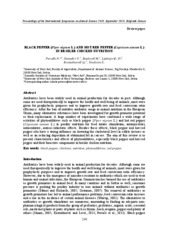| dc.description.abstract | Antibiotics have been widely used in animal production for decades in past. Although some are used therapeutically to improve the health and well-being of animals, most were given for prophylactic purposes and to improve growth rate and feed conversion ratio efficiency. After the ban of nutritive antibiotic usage in animal nutrition in the European Union, many alternative substances have been investigated for growth promoter potential as their replacement. A large number of experiments have confirmed a wide range of activities of phytoadditives such as black pepper (Piper nigrum L.) and hot red pepper (Capsicum annum L.) in poultry nutrition for feed intake stimulation, antimicrobial, antioxidative, anticoccidiostatic effects. Besides these effects, black pepper and hot red pepper also have a strong influence on lowering the cholesterol level in edible tissuses as well as on reducing deposition of abdominal fat in carcass. The aim of this review is to present characteristics and effects of phytoadditives, especially black pepper and hot red pepper and their bioactive components in broiler chicken nutrition. | en |



